There’s a lot of conflicting information about anchor text out there.
One site tells you to focus as heavily on your keywords as you can.
Another tells you to stay as far away from any kind of anchor text and backlinks as possible.
And another says anchor text doesn’t matter.
What are you supposed to believe?
Knowing what anchor text can improve your SEO strategy isn’t always easy – especially when you have a dozen conflicting messages trying to tell you what to do.
But in 2018, it’s essential to optimize your anchor text to attract more attention from search engines.
To help you out, let’s start from the very beginning.
Here’s what anchor text is, how it helps (or hurts) SEO, and what you can do to keep it optimized.
What is anchor text?
Anchor text is the clickable words that appear in place of a hyperlink.
For example, this is anchor text.
Anchor text allows you to add links within your content contextually. It also gives readers – and search engines – a better indication of what they’ll find on the other side of the link.
The anchor text usually relates back to keywords associated with the contents of the link.
However, not all anchor text is created equally.
Let’s take a look at the different kinds of anchor text you might find online.
Exact Match
An exact match anchor text is when the anchor text directly matches the words or phrases associated with the link’s contents.
Here’s an example of anchor text within an article.

If the writer was hoping to target the keyword “chatbots,” this would be an exact match.
Partial Match
A partial anchor text match appears when your targeted keyword is within the anchor text, but it’s not an exact match.
Check out this example.

Say the marketer’s targeted keyword was “guest posting.”
Using “a series on guest posting” is not an exact match, but it does still include the keyword.
This means it’s still targeting the keyword you’re trying to rank for, but it seems more natural.
Branded
Branded anchor text is when the anchor text features the company or individual’s name.
Here’s an example.

This type of anchor text is frequently used when you’re linking to a company’s homepage.
Generic
Usually, anchor text is somewhat hidden within the content.
However, generic anchor text typically stands out and is obviously a link.
Here’s an example.
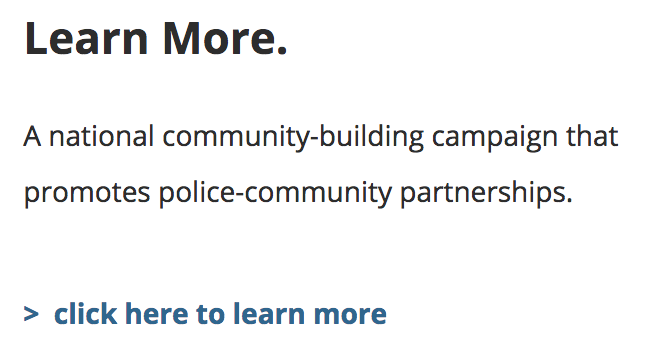
This kind of anchor text usually associates with a call to action.
Generic anchor text is also sometimes called “natural” anchor text.
Images
Images can also be anchor text.
This text occurs when you click on an image, and it brings you through to a link.
However, the actual anchor text associated with the image is the alt text that you include.
LSI Keywords
LSI keywords, or Latent Semantic Indexing keywords, are words or phrases that closely associate with the keywords you’re trying to target.
These might be different names for the same principle or product, or other keywords closely related.
Here’s an example.

The keyword “micro-influencers” is related to influencer marketing, without being a partial match.
Blog Title/Post Title
When the name of the anchor text you’re linking to is the full name of the blog title, page title, or content title, this is simply called Post Title anchor text.
Check out this example.
Like the example, this kind of anchor text usually appears when marketing a course, referencing a specific blog post, or showing off a page.
Naked URLs
A naked URL doesn’t have any anchor text at all.
Instead, it’s just a link to a page featured on your site.
Naked URLs may contain the “www” or might just be “Domain.com.”
Here’s an example from Sprout Social.

The anchor text for this link is the link itself.
This can still appeal to keywords because subdomains typically include keywords.
They can also appeal to branded keywords, including the company name in the domain.
How does anchor text influence SEO?
Anchor text helps search engine crawlers and readers identify what the contents of the link contain.
As more and more websites link to a particular page with various forms of anchor text, the search engine can begin to get a better idea of what kind of content the site provides.
In a way, anchor text is like a keyword that others use to describe your content.
However, it isn’t simple enough to just use anchor text directly associated with the keyword you’re trying to rank for.
In the past, Google relied heavily on anchor text.
Unfortunately, this allowed marketers, writers, and webmasters to do something called “Google Bombing.”
This led to pages ranking for keywords that weren’t related to the content that was appearing.
The most famous example of this is in 2007 when a search for “miserable failure” would result in articles about President George Bush.
In fact, now when you search “miserable failure,” you get results about the Google Bomb.
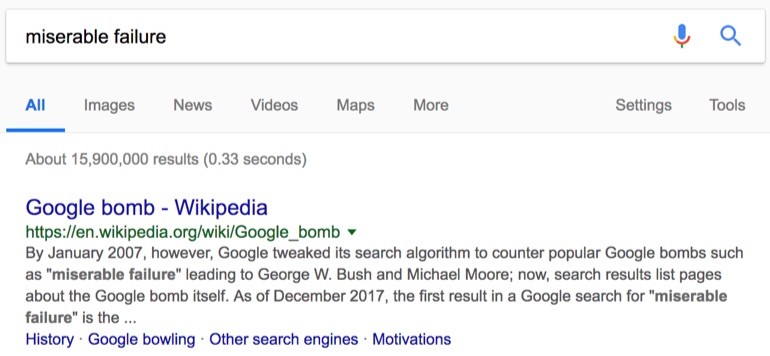
Google responded to this error in anchor text with the Penguin Update, which they launched in 2012.
Like most updates, the search engine released Penguin to help identify spammy listings and remove them from their rankings.
There are two particular triggers for Penguin.
First, links that seem to be purchased, resulting in a number of similar links appearing on low-quality websites around the same time.
Second, links that appear to use keyword stuffing.
This stuffing means that if your anchor text matches your keywords too directly, it could penalize you.
Julie Joyce from LinkFishMedia described anchor text’s importance to SEO by saying, “A site that has 75% exact match anchors has to look unnatural… when I overdo it and it works, it doesn’t stick.”
The idea is that if a website is linking to your content naturally, it will use a more diverse keyword phrase.
While keyword stuffing may help you get results quickly, any change in ranking will only be wiped away when Google discovers this strategy.
So, if you can’t link to the keywords that you’re trying to target, how should you use anchor text to improve your SEO?
Let’s take a look.
How to optimize anchor text for SEO in 2018?
When trying to control your anchor text, there is one thing you want to keep in mind – relevance.
To show Google that your anchor text and link is not black-hat, you need to prove it’s natural – even if it is strategic.
Let’s take a look at how you can do this.
1. Only include links when anchor text fits naturally.
One of the biggest reasons Penguin was first introduced was to stop website owners from adding anchor text just for SEO purposes.
This means they’re on high alert for anchor text that doesn’t seem like it fits.
With the Penguin Update, sites who over-optimized their anchor text saw severe penalties that hurt their web traffic.
To avoid this, you want each anchor text you include to fit naturally within the content.
For anchor text to be SEO friendly, it should be succinct and relevant.
You want your anchor text to describe the contents of the link as accurately as possible in as few words as possible.
Here’s how:
Using the anchor text “start a blog” then links directly to a page about how to start a blog.
It’s direct, to the point, and only features three words.
However, you also want to avoid using an exact match to your keyword as often as possible.
Are you confused?
You don’t have to be.
When trying to decide what to use for anchor text, consider what part of your sentence might spark your reader’s interest the most.
For example, if there is a statistic in your sentence, this would be a great place to include your anchor text.
Check out this example from a Kissmetrics article.
Both readers and search engine will know you’re linking back to that site because it backs up your claim – not because you’re trying to stuff results for that keyword.
The same idea applies to quotes.
As mentioned, anchor text should be direct and to the point.
If you’re linking to an entire quote, this is usually much too long for anchor text.
Instead, make your anchor text the individual’s name or the resource you pulled the quote from like Oro Inc does on this blog.
Here, we have two bits of anchor text.
First, her name is anchor text pointing the reader to her Twitter. Second, there is anchor text pushing the reader to Kate’s blog.
Again, this can show that you’re using that link to support your data or claims.
Relevance is also crucial for anchor text and links.
First, the anchor text you choose to display on your website will influence what Google believes your page is about.
While it’s okay to have a few links that may seem out of context to a search engine, you want most of your anchor text to be within your industry.
If you’re in the finance industry and all of a sudden you have anchor text about baking cakes, this might be a red flag to Google and Penguin.
When adding links and anchor text, first think if it is necessary.
Does it provide value and help make your argument stronger?
Or are you just trying to squeeze in another link to meet some imaginary quota?
Don’t add links just for the purpose of adding links.
Instead, work links into your content as naturally as possible.
2. Make sure you diversify your types of anchor text.
Anchor text variation might be one of the most significant factors when it comes to using links for SEO.
When all your links are one style, this could cause a red flag.
For example, if the only anchor text you use throughout your entire website is exact match keywords, it might seem like you’re not putting genuine thought into what you’re linking to.
A natural link profile will include many different kinds of links.
Let’s take a look at what you want your optimal anchor text profile to look like.
It’s essential to begin by saying that an anchor text profile should look different depending on if you’re a national or local website.
Your homepage and internal pages of a website will also look different.
Let’s cover a national page first.
Serpstat recommends you break down your anchor text distribution like this.
The majority of your anchor text should be branded.
In fact, over half of your anchor text should be branded. This includes anchor text that is branded with a keyword.
You should also notice that exact match anchors are incredibly small.
In fact, you only want exact match anchors to make up about 1% of your entire link distribution.
A partial match should only be about 2%.
Maybe surprisingly, naked links should also make up a sizeable chunk of your link distribution.
Now, let’s take a look at how your sub-pages should compare.
SEOJet breaks down a website sub-page link distribution like this.
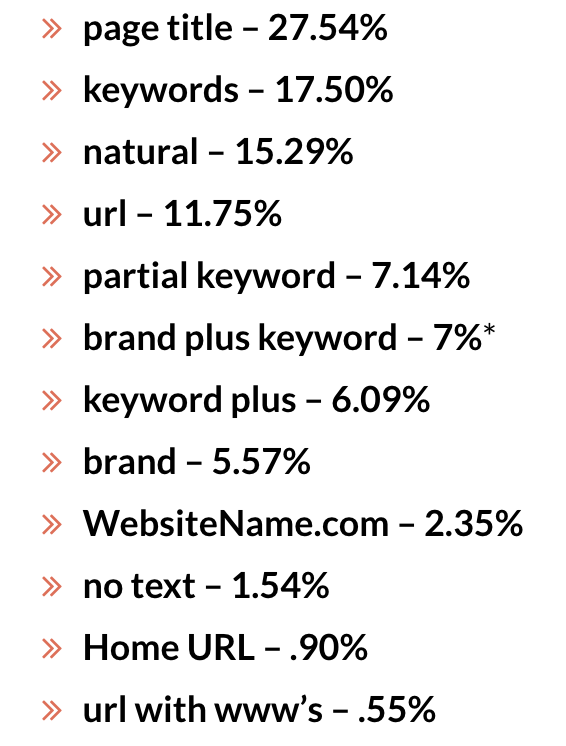
Notice how branded anchor text is much, much smaller than the homepage portion.
For sub-pages, “page title” anchor text had a significant influence on top ranking pages.
This influence typically occurs because page titles usually include the keywords you’re targeting, but they aren’t seen as “exact match” anchor text.
This allows you to easily target keywords within your anchor text without penalties for seeming unnatural.
But you’ll also see that “exact match” keywords are used much more frequently within sub-pages than they are on homepages.
Now, let’s compare this to a local homepage anchor text profile.
For a local homepage, your anchor text profile can be much more diverse.
Unlike the national page, you only need about 20% of your anchor texts to be branded.
But you’ll also notice that your exact match keywords should still be incredibly low.
An internal local page should have the same anchor text profile as a national page.
Keep in mind that these percentages are just recommendations.
You may find that a different distribution brings you better results.
3. Stay away from low-quality or toxic websites.
Google loves high-quality websites.
When considering who to rank at the top of their results lists, they’re going to push sites to the top that they believe fit their list of important factors.
This means gaining high-quality links from awesome pages – and avoiding those that might hurt your “cool” factor.
Let’s break down what bad links are.
Mostly, bad links are links that Google believes you’ve gained unethically, either outgoing or incoming.
On the outgoing side, you have much more control over who you’re linking to.
However, you need to be careful of broken links or people leaving spammy links in your comments section.
If you don’t monitor your comments, they may become bogged down with low-quality backlinks that hurt your reputation.
But the real problem occurs when you have bad incoming links.
Unfortunately, these can be more difficult to control.
Because you can’t delete these links from your website like you can with low-quality outgoing links, you’ll need to find and eliminate your association with them through Google.
If you’re not paying proper attention to where your backlinks are coming from, you could ruin your credibility without even knowing it.
Now, let’s talk about how you can find these low-quality links.
The Moz Spam Analysis tool is one way you can check the quality of websites you connect with.
The Spam Score, which their Open Site Explorer features, gives you a ranking of each link.
The tool uses 17 different flags to identify links that might be seen as spam, including things like content strength, if there is contact info on the page, or if the domain name contains numbers.
If a domain has fewer than four flags, it is considered a strong link.
However, if there are more than seven, this could be seen as a bad link and should be looked at.
If there are links with over ten red flags, this could be severely damaging to your online reputation.
Google allows you to disavow any low-quality links that you believe is hurting your online ranking.
When you disavow a link through Google, you’re letting the search engine know that you do not wish to associate your website with that link.
To disavow your backlinks, you want to begin by finding the low-quality links that would be damaging your site.
If you’ve already done this with the Moz Spam Analysis tool or another backlink tool, you can move on to the next step.
Through the Google Disavow Tool, you can upload your list of links to disavow.
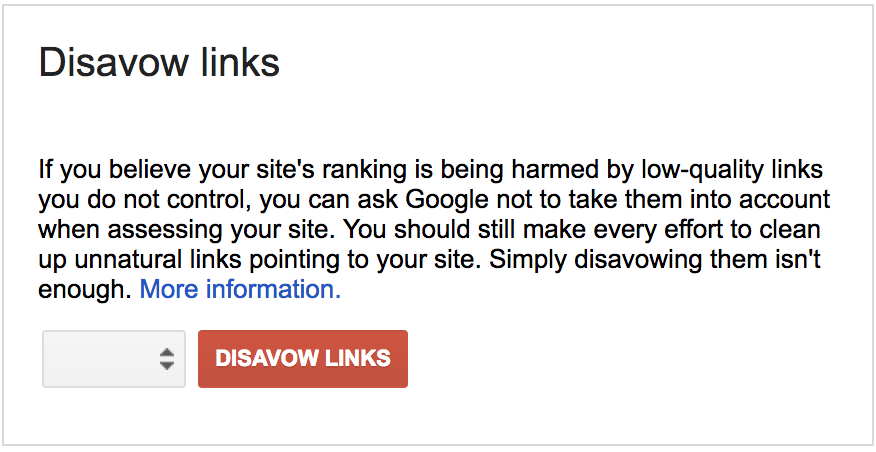
Keep in mind that it can take a few weeks before you start to see your links disavowed.
Let’s consider this case study IMPACT did on Udemy.
Upon doing a keyword audit, they found that just over 67,000 domains were linking to Udemy 6.35 million times.
If you break this down, it means that each site was linking to Udemy 94 times.
Unfortunately, this probably isn’t accurate and can bring up a red flag for Google.
With a bit of additional digging, they found that one website alone was linking to Udemy over 400,000 times.
This kind of unnatural linking may not be Udemy’s fault or intention, but it can still cause severe damage with search engines.
When determining high-quality and low-quality links, you’ll also want to consider something called co-occurrence and co-citation.
Co-occurrence happens when you use similar keywords to other sites across the web.
These are similar to LSI keywords.
However, it can influence your SEO by allowing you to rank for terms you may not have been targeting.
Co-occurrence goes hand-in-hand with co-citation.
Co-citation happens when two different websites mention the same brand but do not link to that brand or website.
Those two sites then get connected through the mutual mention of the third website.
Both co-occurrence and co-citation can help you become associated with other high-quality websites.
4. Go deep with your anchors.
Another critical aspect of anchor text and backlinks is what content you’re linking to.
Google wants to see that you’re linking to valuable pages within a website.
Not only does this improve relevance, but it also seems more natural than if you’re just linking to a homepage or product page.
When deciding what to link to, choose the most relevant page possible.
If linking to a study, quote, or statistic, pull the actual page that information came from – not just the homepage.
Always opt for shareable content over surface-level generic pages.
Here’s an example from Moz.
While the anchor text says “Moz blog,” you’ll see that the link pushes back to a specific blog – not just the blog page.
This kind of specificity pushes both Google crawlers and readers deeper into the page, creating more relevance and making a more genuine impression.
It seems much more natural to link to this kind of in-depth, specific content and will improve your credibility with Google.
However, it is okay to have some of your anchor text push back to a surface-level page.
For example, if you’re going to link to a specific brand, it’s okay to have that link push to the company’s homepage.
You don’t want these kinds of links to make up the majority of your distribution.
Conclusion
As with any SEO factor, you want to include anchor text and links within your content as naturally as possible while providing clear value to your readers.
If you’re merely stuffing links into your content, you can severely damage your reputation with Google.
This can make the already uphill battle of getting web traffic even more difficult.
Understanding anchor text and adequately optimizing each link can help improve your ranking while also driving traffic to your page.
Keep these four optimization tips in mind when creating your website and backlink strategy.
What anchor text strategies are you using in 2018?
About the Author: Neil Patel is the cofounder of Neil Patel Digital.
from The Kissmetrics Marketing Blog https://blog.kissmetrics.com/anchor-text-seo/




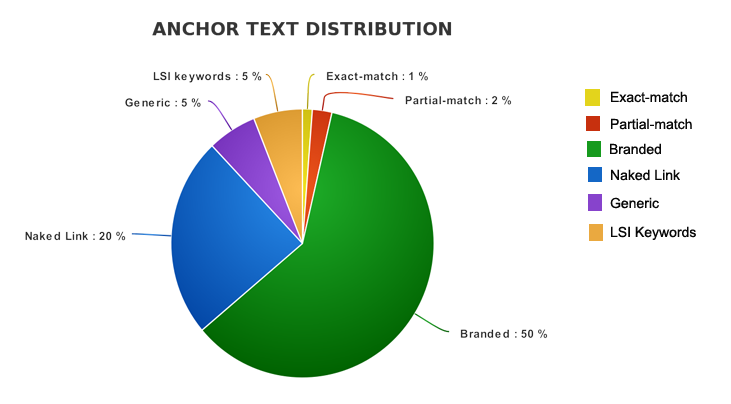
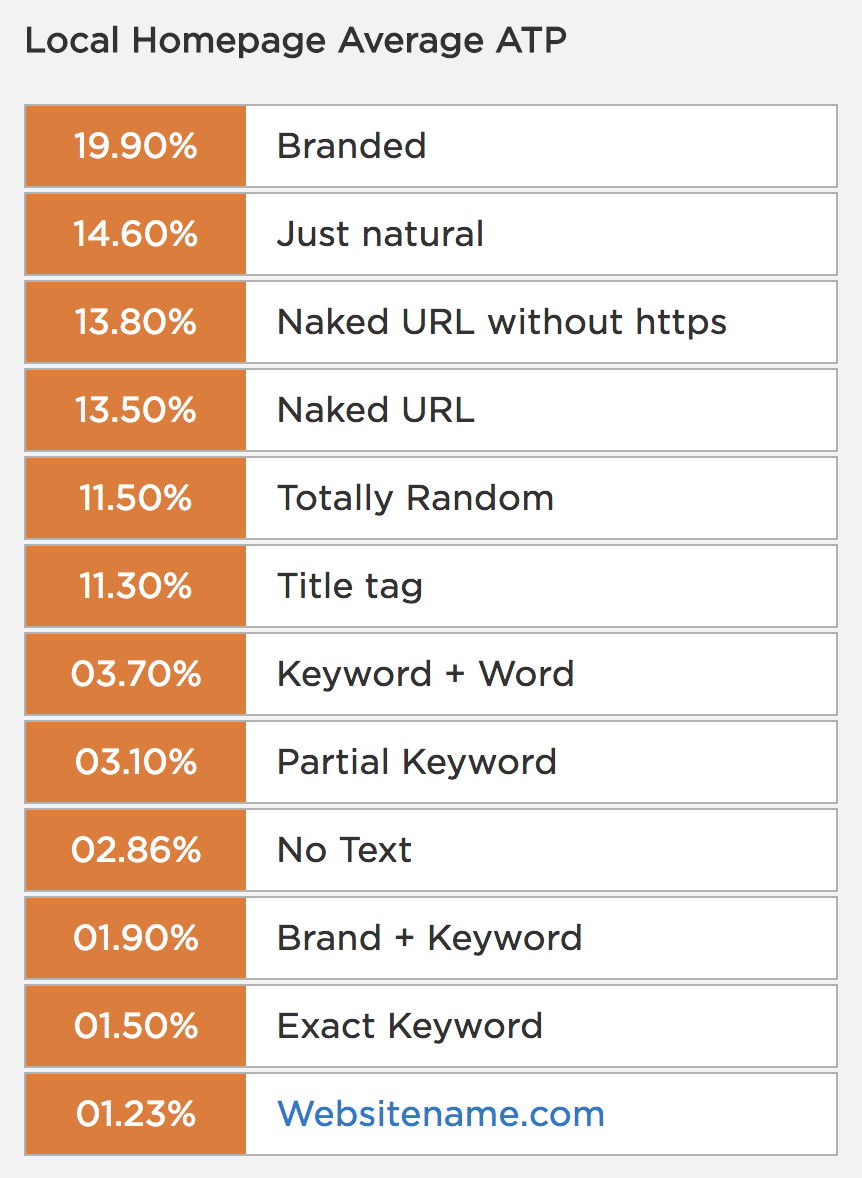
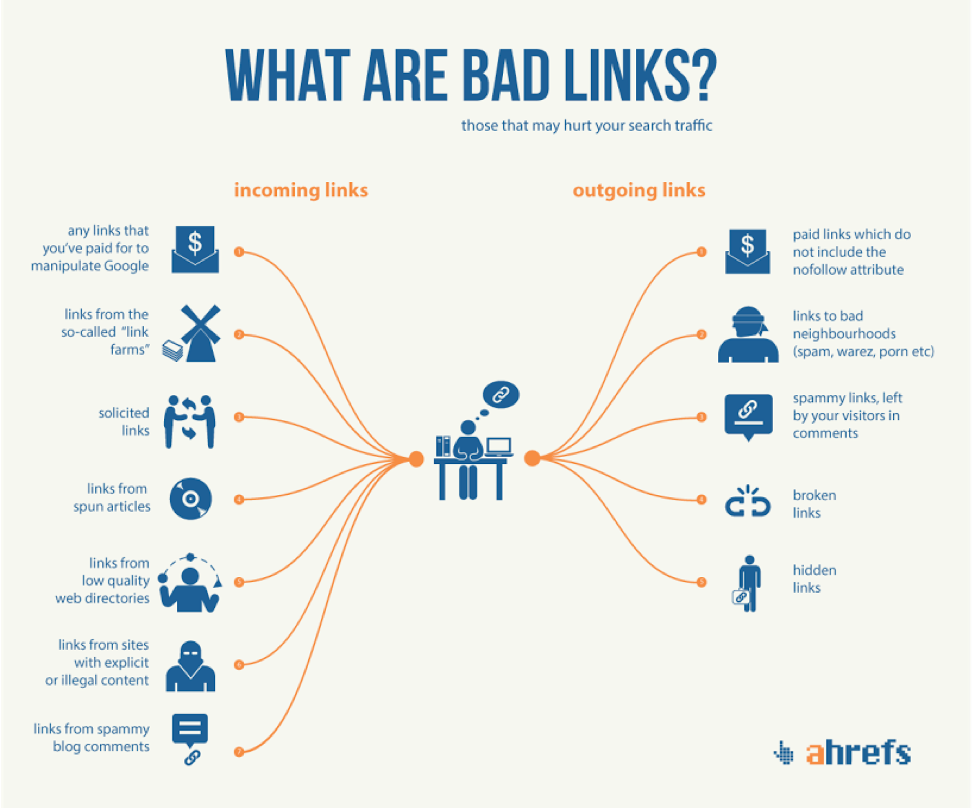
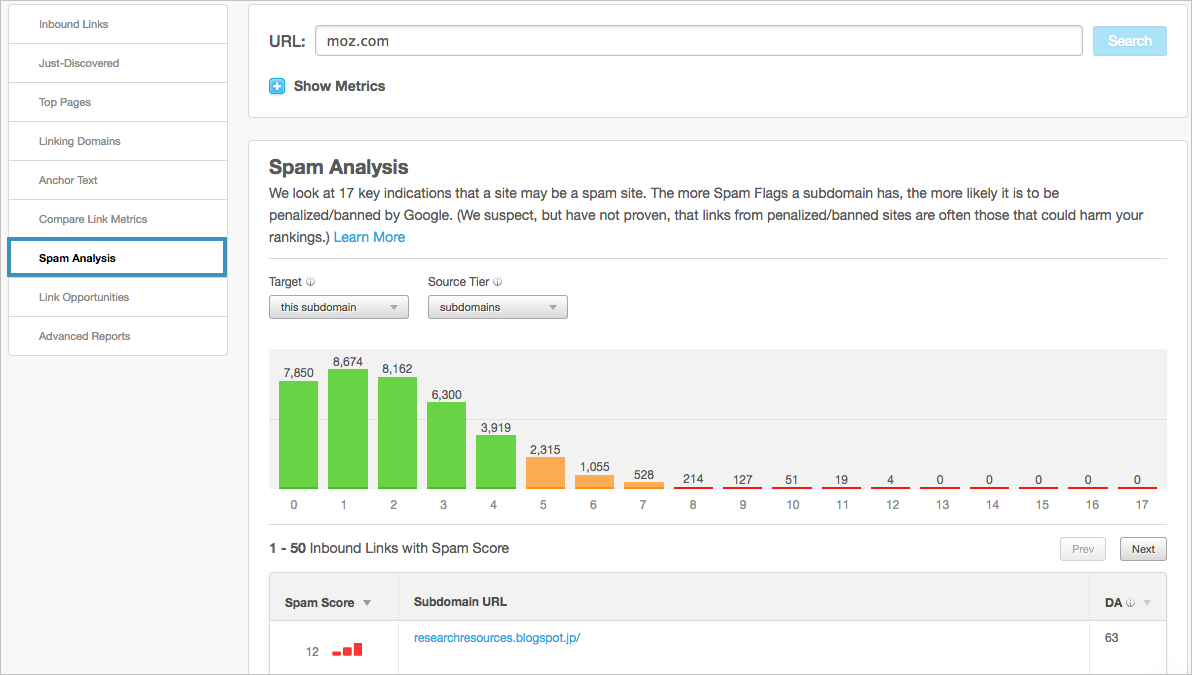



No comments:
Post a Comment